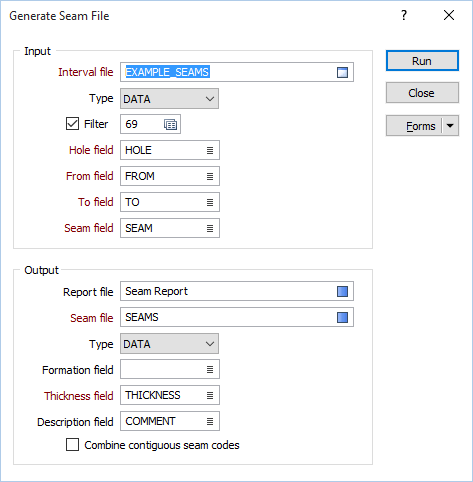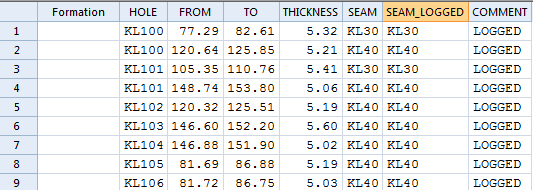Generate Seam File
The output to the process is a Seam file. A Seam file is an Interval file which has additional fields that record the status of all logged and inserted seams. The Seam file is used as an input to various Seam Stratigraphic functions.
![]()
Input
Specify the following inputs in the Generate Seam File form:
Interval file
Double-click (F3) to select an Interval file (typically lithology) that contains the seam data you want to extract.
Hole, From and To fields
Double-click (F3) to select the names of the fields in the Interval file that contain the Hole identifiers and From and To intervals.
Seam field
Double-click (F3) to select the name of the field that will be used to define the records to be written to the output Seam file. If this field is blank the record is skipped, otherwise it is assumed to define a seam. If this condition is not sufficient, an appropriate filter needs to be defined.
The content of the Seam field is duplicated into a field with a “_LOGGED” suffix. The content of the Seam field can be modified by subsequent processes, however the _LOGGED field remains unchanged, to indicate the original seam coding for that interval.

The output file will look something like this:

The optional Formation field will allow seams to be grouped into units that will (later) be modelled separately. A Description field will be populated by comments that indicate the derivation of each interval.
Output
Report file
Optionally enter the name of a Report file. If errors are encountered during processing, any erroneous records in the file are reported. A seam identifier and an indication of the type of error is reported for each record.
The following errors are reported:
- FROM or TO value is blank
- FROM value greater than TO
- Overlapping Intervals
- Seam Repeated (Not in Sequence)
- Seam Repeated (Not Contiguous)
Each of these errors will mean that some “seam” records from the Input file will not be written to the Output file. In particular:
| Seam Repeated (Not in Sequence): | There are consecutive records representing the same seam, but with a gap between them. No intervals after the gap are written to the Output file. |
| Seam Repeated (Not Contiguous): | This might occur when the hole intersects a reverse fault. The remedy is to create a duplicate hole. One hole will reference intervals above the fault, the other intervals below the fault. |
Seam file
Enter or double-click (F3) to select the name of the output Seam file. A Seam file is an Interval file which has additional fields that record the status of all logged and inserted seams. The Seam file is used as an input to various Seam Stratigraphic functions.
Formation field
(Optional) Double-click (F3) to select the name of the field that contains the values that identify each formation. A Formation is a group of seams, modelled independently.
Thickness field
Double-click (F3) to select the name of the field that contains the Thickness values calculated from the From and To interval values in the Interval file.
Description field
(Optional) Double-click (F3) to select the name of a Description field. The Description field will be populated by comments that indicate the derivation of each interval.
Combine contiguous seam codes
Select this option if you want to combine records in the Interval file which have contiguous seam codes.
If there are 3 contiguous intervals for the same seam, and that seam splits into 3 plies, then the interval boundaries that are already defined are used as the splits. If the number of intervals and the number of splits do not match, the seam is combined into a single unit and is then split using either the percentage values in the Stratigraphy file, or by modelling the surrounding holes.
(Note that the Interpolate Seams function also combines contiguous intervals, and takes these into account when there are seam splits).
Forms
Click the Forms button to select and open a saved form set, or if a form set has been loaded, save the current form set.
Run
Finally, click the Run button to begin the process.